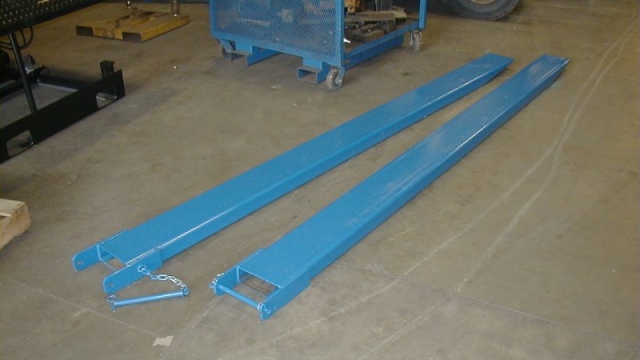
In today’s fast-paced industrial environment, maximizing efficiency is more important than ever. One key factor in enhancing operational productivity is ensuring that your equipment is optimized for the tasks at hand. For those who rely on forklifts, understanding the value of fork lift extensions can make a significant difference in how effectively you can handle various loads and reach those challenging heights or depths.
Fork lift extensions are versatile tools that can transform your forklift into a more capable machine, allowing it to handle larger loads or reach areas that standard forks simply cannot. Whether you are involved in warehousing, construction, or manufacturing, harnessing the power of these extensions can streamline your operations, save time, and improve safety. In this guide, we will explore the different types of fork lift extensions available, their benefits, and essential tips for their use, helping you to get the most out of your forklift investment.
Understanding Forklift Extensions
Forklift extensions are specialized attachments designed to increase the lifting capacity and reach of standard forklift forks. They are particularly useful in warehouses and construction sites where the standard fork length may not suffice for moving larger pallets or materials. By extending the reach, operators can more efficiently handle heavier loads without the need for specialized equipment, ultimately improving productivity.
These extensions come in various sizes and designs, allowing users to select the right fit for their specific needs. Some extensions are made from lightweight materials that enhance maneuverability, while others are constructed from heavy-duty steel for added strength and durability. It’s crucial to choose the appropriate type based on the load requirements and the type of forklift being used to ensure safety and efficiency.
Proper usage of forklift extensions is vital to prevent accidents and maintain operational integrity. It is essential for operators to be trained on how to attach and use these extensions correctly, as improper usage can lead to tipping or loss of load. Regular inspection of the extensions is also recommended to detect any wear and tear that may compromise their effectiveness and safety.
Forklift Extension Forks
Types of Forklift Extensions
There are several types of forklift extensions designed to enhance the reach and functionality of standard forklift forks. The most common type is the hook-on extensions, which can be easily attached to the existing forks without any modifications. These extensions are useful for lifting larger or longer loads, making them ideal for tasks such as moving lumber or pallets that exceed the dimensions of standard forks. Their ease of installation makes them a popular choice among operators who require flexibility in their lifting capacities.
Another type is the slip-on extensions, which are designed to slide over the forks and provide additional length. These extensions typically have a secure locking mechanism to ensure they stay in place during operation. Slip-on extensions are sturdy and can manage heavier loads, making them suitable for warehousing and construction applications. They come in various sizes to match different fork lengths, ensuring compatibility for a wide range of forklifts.
Finally, there are specialized extensions such as the fork leg extensions, which are designed to raise the overall height of the forks. This type is particularly useful for reaching higher shelves or for loading and unloading trucks that are elevated. The fork leg extensions allow operators to work efficiently in tight spaces without compromising safety or stability. By choosing the appropriate type of forklift extension, operators can significantly improve their productivity and safety in material handling tasks.
Benefits of Using Forklift Extensions
Using forklift extensions can significantly enhance the versatility of your forklift operations. With the added length, these extensions allow for lifting and transporting longer and bulkier loads that standard forks may struggle with. This increase in capacity can lead to improved efficiency in warehouses or construction sites where managing larger materials is a common requirement.
Another benefit of forklift extensions is their ability to reduce the risk of damage during loading and unloading. By providing a more secure grip on larger items, extensions help ensure that loads are handled properly and do not slip or fall. This not only protects the materials being moved but also minimizes the risk of injury to workers, contributing to a safer work environment.
Lastly, using forklift extensions can lead to cost savings in the long run. Instead of purchasing additional forklifts or specialized equipment for specific tasks, investing in extensions can make your existing forklifts more adaptable. This approach maximizes the equipment you already have, streamlining operations and reducing the need for extensive capital expenditure.
Safety Considerations
When using fork lift extensions, safety should always be the top priority. Operators must ensure that the extensions are compatible with the specific fork lift being used. Each fork lift model has a designated capacity, and exceeding this limit can lead to tipping or loss of control. Before attaching extensions, it is crucial to check the manufacturer’s guidelines to confirm that they meet the necessary specifications for safe operation.
Proper training for operators is essential when it comes to using fork lift extensions. Operators should be familiar with the changes in load capacities and handling, as extensions can significantly alter the dynamics of lifting operations. Regular safety training sessions can help ensure that operators understand the risks involved and how to mitigate them while using these extensions.
In addition to operator training, conducting regular inspections of the fork lift and its extensions is vital. Before each use, operators should inspect the extensions for any signs of wear or damage. A thorough inspection can prevent accidents caused by faulty equipment. Furthermore, maintaining a clean and organized work environment can reduce the risk of accidents and enhance overall safety when operating fork lifts with extensions.



